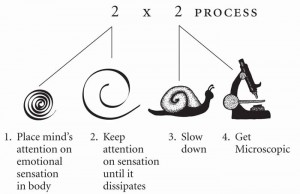Compendium of Emotional Connection
Principles and Practices
The 2 X 2 Process
In order to experience emotions directly, turn your attention to your body. Whether an emotion appears immediately or is at first blocked by a contraction, keep your attention on the flow of physical sensation until you reach an expanded state. The quality of your attention is as important as its placement. Slow down your awareness so that emotions are free to arise and clear in their own natural time. Get microscopic in your awareness so that emotions can reveal themselves fully, moment-by-moment, beyond the usual labels and abstractions.
Here is a diagram to help demonstrate the process.
Essential Terms
Contraction — a temporary system lockdown, experienced either as tension (fight/flight) or numbness (freeze).
Expansion — a quality of openness and flow. It coexists naturally with positive emotions, but it can also coexist with any emotion. Emotional connection of any kind produces expansion.
Addiction/Compulsion — the continuous use of any substance or activity to create disconnection from one’s emotions.
Advanced practices for challenging emotions:
Breath —Use actual breath and/or your mind’s eye. Inhale directly into the stuck bodily sensation. Exhale through that same place, helping to restore inner space and flow.
Posture-movement-sound—Express the internal “vibration” of an emotion by translating it into these external forms.
Touch—Place a gentle hand on a tense or otherwise uncomfortable physical spot. Keep your hand still or caress the spot lightly.
Direct Inquiry—Let the contraction or emotion speak directly, unmediated by thoughts and concepts. Hear the emotion’s “voice” to support acceptance of its subjective truth.
Cradling—Cultivate a quality of emotional attention that resembles the spacious, caring way a parent instinctively holds a distressed infant.
Mental detachment—Maintain an even-keeled awareness of thoughts, beliefs and stories that arise while practicing 2 X 2. Rather than pushing them away or getting lost in them, simply note their presence, along with any immediate response they produce, and then return your focus to emotional flow.
Impediments to Emotional Connection:
Analyzing—Trying to figure out why an emotion is occurring rather than experiencing it directly.
Judging—Looking for what’s wrong with an emotion, or with you for having it, rather than continuing to feel.
Assessing —Getting lost in an evaluation of your process, which usually takes the form or an obsessive quest to “do it right.”
Bargaining—Placing any pre-set limits or conditions on emotional connection, whether in regard to duration, depth, or outcome.
Using emotional connection to get unstuck:
Find the flinch—Identify the aspect of moving forward with your vision that causes you to pull up short.
Cut to the Chase—Discover your worst-case scenario in moving forward, and determine how that outcome would make you feel.
Weather the storm—Use all your creative power to imagine that outcome as a reality, then surf the whole cascade of emotions that comes with it.
Repeat as necessary—Apply the above course of action whenever you get stuck again in pursuit of your goal, regarding both the same emotions and any possible new ones.
Understand the Triune Brain—This working model of your mind supports the above method for getting unstuck. It presents the brain’s three main systems—primitive, limbic, neo-cortex—in order of their evolutionary development. Following the same order in any difficult situation is the fastest, easiest way to restore peak function. In other words, first release whatever contraction is present (primitive brain). Next, feel all the emotions present (limbic system). Then, and only then, employ creative, abstract reasoning (neo-cortex). Attempting to achieve peak function in any other order, by contrast, foments confusion, repression, and further internal conflict.
22 Key Refinements:
Reconstructed walkthrough — To reveal and release the emotional “motor” of a compulsion, focus on a recent and/or intense version of the usual compulsive episode. Replay it in your mind’s eye in super-slow motion, with special attention to your bodily state at each micro-moment. Once you zero in on the emotions that usually get glossed over, stay with them till the onset of expansion.
Images and personas—Recognize that emotions often arise with corresponding internal images. Welcome these images as pathways to deeper understanding and release. Stay especially attuned to images of yourself at very young ages, experiencing related challenges to whatever you face currently.
Done deal delay—When the trip-wire goes off in your brain to engage in compulsive activity, experiment with brief delays in assenting to that habitual decision. Increase the delay slowly and incrementally, using the 2 X 2 process to attend to all the contraction and emotion that inevitably results. Notice, as the underlying emotions receive this new attention, how the intensity of the compulsive response begins to diminish.
Self-acceptance—In asserting our will power to change personal behavior, one part of us inevitably fights against another. In such a case, the losing side always exacts some kind of revenge. This is referred to as pushback, and it leads to a new, unhealthy equilibrium even if the originally desired change has occurred. To avoid this, practice self-acceptance, which means connecting emotionally to all parts of you, even the ones you don’t want. Self-acceptance allows you to move from an either/or perspective to one of both/and.
The no fail zone—If you attempt to practice the 2 X 2 process and don’t succeed, consider this not a failure but a learning opportunity. Pay close attention to what shut you down, thereby allowing you to be more prepared for it the next time. This practice is a form of self-acceptance vital for clearing the most scary and entrenched emotions.
Pinpointing —Emotional connection can only proceed as quickly and fully as the most tentative part of you can go. When you dive in too fast, significant pushback results. To pinpoint means breaking down your experience of a difficult emotion into tiny, manageable amounts. For best effect, cultivate an honest, patient, consistent awareness of your limits.
The adrenalin factor—A rush of adrenalin in connection with any compulsive activity is a sure indicator of emotional repression. Think of it as a giant stop sign, and then use the ensuing pause to unravel the urge’s emotional content.
The need beneath the need—A compulsive desire is both a call for attention and a kind of lie. It tricks us into thinking that satisfying the desire will lead to fulfillment. The truth is that underneath every compulsion is a deeper need for emotional connection. Satisfy this need and the compulsion wanes.
The fork in the road—Before making important decisions, assess the degree of resistance present in each possible choice. Only when you’ve used the 2 X 2 process to render all paths resistance-free can you be confident in both the decision-making process and the decision itself.
Tactical empathy—Developing the ability to resonate with your own emotions also makes it possible to resonate with other people’s emotions. Tactical empathy means employing such resonance with partners and groups, while simultaneously remaining connected to yourself, to serve the highest good of all.
The emotional audit—Emotions, and resistance to them, play a dominant role in almost every group. This dominance is usually unconscious and rarely understood. An emotional audit reveals a group’s general ethos, as well as the way emotions are approached, understood, valued, shared, and processed. There is no one best way to perform such an audit. Choose a method for your group that’s likeliest to produce the greatest degree of honesty and cooperation.
Mutability—The 2 X 2 process illuminates the way emotions shift fluidly from one to another, both moment-by-moment and over time. In addition, multiple emotions often arise about a single topic. This is totally natural. As long as you meet all such mutability with a both/and orientation, it will enrich your emotional connection rather than impede it.
Exaggeration—When advanced practices for emotional connection don’t lead to sufficient feeling and expansion, exaggeration is the next option. Dramatize and express the emotion far beyond its actual intensity. Often this breaks the logjam, allowing you to quickly resume ordinary 2 X 2 with the emotion in its unexaggerated state.
Emotional Association—While exaggeration is an experiential way to get unstuck, emotional association is its mental correlate. Here, simply ask yourself, “When have I felt this way before?” Let the past events that surface in response to this inquiry both illuminate and add “juice” to your current attempt at connection. If the above question doesn’t do the trick, also try asking, “What similar situations have I experienced before?”
Working with physical pain—Sometimes physical pain is somatized, meaning that it’s been created as a result of resisted, unconscious emotion. In addressing any ache or pain that is as yet undiagnosed, connect to it for at least five minutes with the 2 X 2 process. If an emotion is indeed the cause, this will allow it to surface and release, eliminating most or even all of the pain. When an emotion isn’t the cause, attending to bodily complaints in this way still reveals how you feel about the pain. It also creates the best internal environment to ease discomfort of any type or origin.
Protective and core emotions—Emotions often arise to screen us from other, more challenging emotions. When this happens they’re a part of our primitive brain’s defensive mechanism. Maintaining a sustained connection with protective emotions enables core ones to surface and clear. Until they do, such protective-core patterns remain stubbornly fixed.
Proportional Response—Life inevitably presents situations where complete emotional connection, or complete emotional repression, isn’t optimal. For these middle-ground situations, use the practice of proportional response, connecting with just the right amount of emotion to keep you sufficiently present and expanded for the task at hand. Once the current challenge has passed, find the soonest possible time to employ the 2 X 2 process full-force.
Button Power—The people and situations that push our buttons, while definitely unpleasant, also provide the greatest possibility for emotional breakthrough. Keep a keen eye out for whatever pushes your own buttons both frequently and intensely. Train yourself, for maximum effect, to apply the 2 X 2 process right in the heat of the moment.
Drop the rope—When two people are in resistance, it’s all too easy for conflicts to escalate. Just one person, however, has the power to break this cycle. As soon as you become aware that you’re in such a tug-of-war, drop the rope using these steps: 1) Find your physical contraction; 2) Describe the sensations of that contraction to your counterpart; 3) Pause the discussion and separate; 4) 2 X 2 until expansion occurs; 5) Resume the discussion, resistance-free.
Positive Boundaries—A positive boundary is a non-defensive approach to self-protection that allows you to feel both safe and expansive at the same time. To create one, connect to the state of well-being within yourself, and then use your mind’s eye to imagine it extending beyond your physical body. Stretch your boundary to a distance at which usually hurtful comments and behaviors no longer make a serious dent. With practice, you’ll need to stretch it less and less.
Containment—Most emotions compel us to talk about them, and we often do so long before a conversation can actually produce a beneficial result. Containment, therefore, is an indispensable tool. As a general rule, don’t talk about an emotion until you’ve connected with it directly for a significant amount of time. If possible, wait until you’re become fully expanded.
Seeing through projection—When projecting, we misplace our thoughts, feelings or interpretations about one person upon another. Resisted emotion is almost always the cause, and emotional connection is almost always the solution. There are three reliable indicators that you may be projecting in a given situation: 1) Physical contraction; 2) An excessive reaction; 3) Persistent thoughts about a similar event from the past. To spot possible projection in other people, look for the presence of indicators two and three above. In addition, if you ask people directly whether they might be projecting, a highly charged response provides another affirmative sign.
Six Additional Tools
Distinguishing between soft and hard resistance—Soft resistance is a temporary, easily surmountable inclination not to feel. Hard resistance is a recognition that is time is definitely not right for emotional connection. When you can’t tell which you’re experiencing, give the 2 X 2 process another full minute. At that point, if your connection has been genuine, any remaining resistance is more than likely hard.
Screen door—If you want to avoid feeling the emotions of those around you, and don’t want to erect a positive boundary, instead imagine yourself as a screen door. Regard all emotions you experience as breezes blowing through the screen. Emotions that “stick” are yours to feel, and all the rest will pass right through.
Proportional vulnerability—People vary widely in their openness to the emotion of others. It makes good sense, therefore, to assess every person and social situation in this light. Reveal only as much of your emotions as will likely be welcome. When in doubt, proceed with caution, re-calibrating your vulnerability often to meet current conditions.
Handling your inner two-year-old —Most of us have a lively internal naysayer, stuck forever in the “terrible two’s,” who raises a ruckus in regard to many of our necessary activities. Meet your own naysayer with a both/and perspective, letting it have a complete say. This approach reveals that the goal of most tantrums is to be heard, not to actually thwart your actions. Once you give your inner two-year-old the chance to stomp around and protest, it usually settles right down.
How not to take things personally—Consider people and their behaviors to be natural, unavoidable parts of the world around you. Birds fly, fish swim, people hurt your feelings. When you accept this as a fact, and not a “problem,” it gives you the opportunity to detach your attention from the cause of an upset and shift it to the physical result. Once you’re surfing your own emotions, the original hurt will quickly lose its sting. This frees you to address the overall situation, and the offending party, with a much lighter touch.
One syllable communication—Many emotions need to be expressed simply as raw energy. When this happens, words can get in the way and end up causing all kinds of additional, unnecessary problems. In place of words, a groan, growl, “Ow!” or “Hey!” often gets your point across safely and quickly. Sometimes, such one-syllable utterances even leaven the situation with humor.



